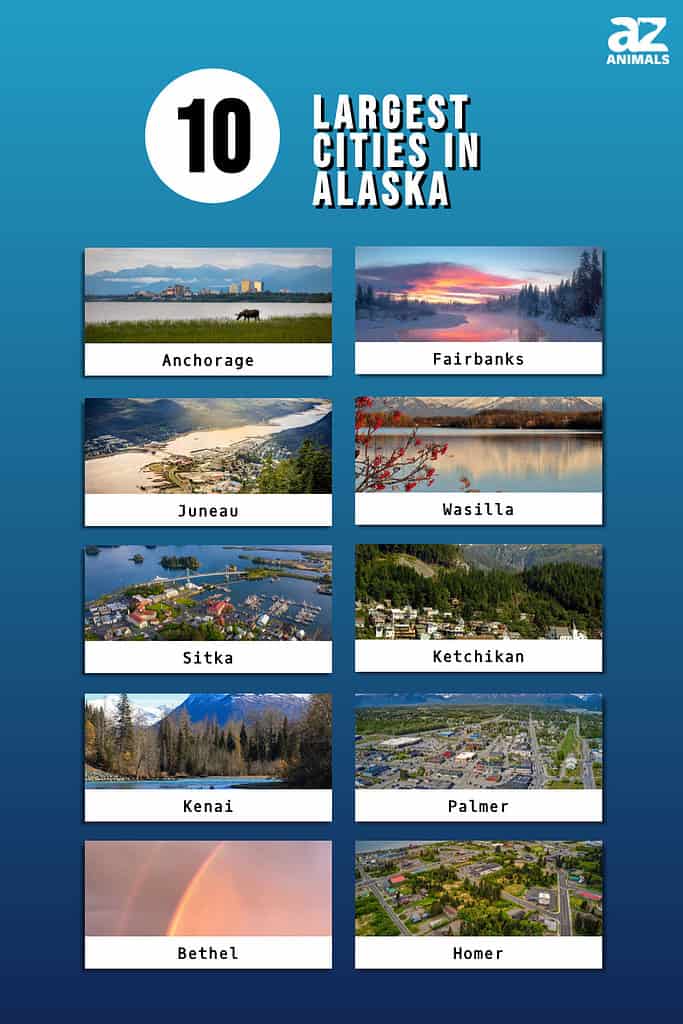
Alaska is known as the largest state in the United States in terms of size, but what about its population? The state is divided into 19 organized boroughs alongside an unorganized one. The largest cities in Alaska are located in only a few of these boroughs.
Unlike other states, most of Alaska’s population is in specific areas. Most people moving to the state are either trying to escape the busy city life or are there for job opportunities. That being said, Alaska’s population has been in constant flux these past few years.
So, let’s discover 10 of the largest cities in Alaska. Below, we’ll review the population, total area, and economic impact. That way, you can be up to date on all information about Alaska!
Measurements Used
While some measurements, such as population, land mass, and annual growth rate, are straightforward to understand, others are not. Below, we use a few different terms and calculations to help describe an Alaskan city and how well they are doing economically and demographically.
Gross Domestic Product
Gross Domestic Product (GDP) measures the dollar value of final goods and services annually in a country, city, or state in a given period. It’s used to help describe the output generated inside the area’s borders. The formula for calculating GDP is as follows:
“GDP = private consumption + gross private investment + government investment + government spending + (exports – imports)”
Population and Population Density
Population measures the number of people living in a specific area. This can be a town, city, neighborhood, or country. On the other hand, population density measures the population against the amount of land in a specific area. The formula would look like the following:
“Population density = total population / total landmass“
Largest Cities in Alaska By Population
| Rank | City | Population | Population Density (per mile) | Annual Growth Rate |
|---|---|---|---|---|
| #1 | Anchorage | 290,637 | 166 | -1.4% |
| #2 | Fairbanks | 32,619 | 1,035 | -1.2% |
| #3 | Juneau | 32,195 | 12 | -1.8% |
| #4 | Wasilla | 9,054 | 821 | +7.2% |
| #5 | Sitka | 8,458 | 3 | -0.8% |
| #6 | Ketchikan | 8,192 | 2,063 | -1.5% |
| #7 | Kenai | 7,424 | 269 | +3.2% |
| #8 | Palmer | 5,888 | 1,286 | +7.3% |
| #9 | Bethel | 6,325 | 141 | -0.8% |
| #10 | Homer | 5,522 | 441 | +6.4% |
Largest Cities in Alaska By Land Mass
| Rank | City | Total Land Area (square miles) |
|---|---|---|
| #1 | Sitka | 4,815 |
| #2 | Juneau | 3,255 |
| #3 | Anchorage | 1,947 |
| #4 | Bethel | 50.11 |
| #5 | Kenai | 35.97 |
| #6 | Fairbanks | 32.7 |
| #7 | Homer | 25.25 |
| #8 | Wasilla | 13.13 |
| #9 | Palmer | 5.07 |
| #10 | Ketchikan | 4.9 |
Largest Cities in Alaska By Economic Impact
| Rank | City | GDP (2021) |
|---|---|---|
| #1 | Anchorage | 28,210.676 million |
| #2 | Wasilla | 63,750.2 million |
| #3 | Fairbanks | 6,477.984 million |
| #4 | Kenai | 3,070,355 thousand |
| #5 | Juneau | 2,228,455 thousand |
| #6 | Ketchikan | 957,850 thousand |
| #7 | Bethel | 723,486 thousand |
| #8 | Sitka | 513,094 thousand |
| #9 | Ketchikan | N/A |
| #10 | Homer | N/A |
#1: Anchorage

Anchorage is the hub station of the entire state and is the largest city.
©BILD LLC/Shutterstock.com
Anchorage is the largest city in Alaska by population, area, and economic impact. The 2020 United States Census data lists that Anchorage has a population of 290,637. The population density is listed as 166 people per square mile.
Aside from that, Anchorage is a very diverse place and has the following races:
- White 60.3%
- Black or African American 5.4%
- American Indian or Alaska Native 7.2%
- Asian 9.7%
- Native Hawaiian or Other Pacific Islander 2.9%
- Two or more Races 11.8%
- Hispanic or Latino 9.5%
- White alone, not Hispanic or Latino 56.1%
Anchorage covers 1,947 square miles and is the largest city in Alaska. To put this in perspective, it is the 134th largest metro area in the United States. While this doesn’t seem like a lot, in terms of size, it’s the most extensive metro area in Alaska. Anchorage’s economic impact or gross domestic product in 2021 is $28,210 million.
Major economic sectors in Anchorage are transportation, military, oil and gas, local and federal government, and convention and tourism. Major employer companies include AOGA, Afognak, and Alaska USA. Anchorage has seen employment averages of 144,000 in 2022, with a 3% job increase from 2021.
The city of Anchorage is 61 degrees north, 5.5 degrees below the Arctic Circle. Due to this, it has a subarctic climate. Just outside the town is Chugach State Park, which has abundant wildlife.
#2: Fairbanks
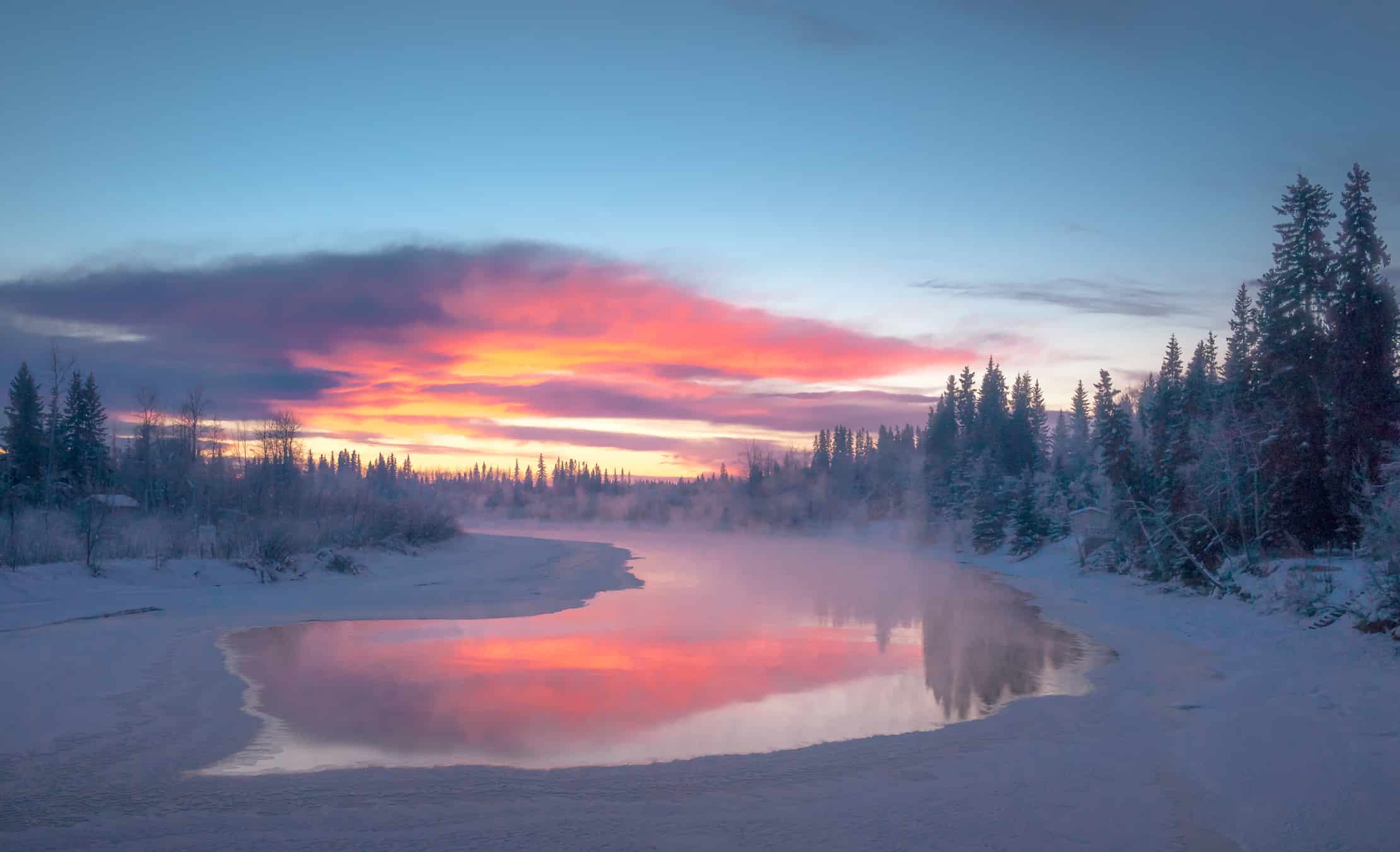
The Chena River is a must-see attraction, as it’s beautiful in each season.
©iStock.com/Elizabeth M. Ruggiero
One of the second-largest cities in Alaska is Fairbanks. According to 2020 Census data, the population of Fairbanks is 32,619. On the other hand, the population density is 1,035 people per square mile. While this seems comparably high for any city, Fairbanks doesn’t take up that much space.
Fairbanks is somewhat diverse and has the following races:
- White 66.5%
- Black or African American 8.3%
- American Indian or Alaska Native 9.3%
- Asian 4.1%
- Native Hawaiian or Other Pacific Islander 0.2%
- Two or more Races 8.9%
- Hispanic or Latino 10.8%
- White alone, not Hispanic or Latino 60.7%
The city of Fairbanks is 32.7 square miles and is the second-largest city in Alaska. It’s comparable to a small town in other U.S. states. The current economic impact or gross domestic product in 2021 is $6,477.984 million.
The town of Fairbanks is supported by mining, tourism, the Univerity of Alaska, and the military. Major employers include the University of Alaska, Doyon, Limited, and the Fairbanks Memorial Hospital.
Fairbanks is next to the Chena and Tanana Rivers in the Tanana Valley. Unlike Anchorage, Fairbanks has a humid continental environment that closely borders a subarctic climate. This means that the city has long cold winters with short warm summers. Just north of the town is a chain of hills that rise until it meets the White Mountains and Yukon River.
#3: Juneau
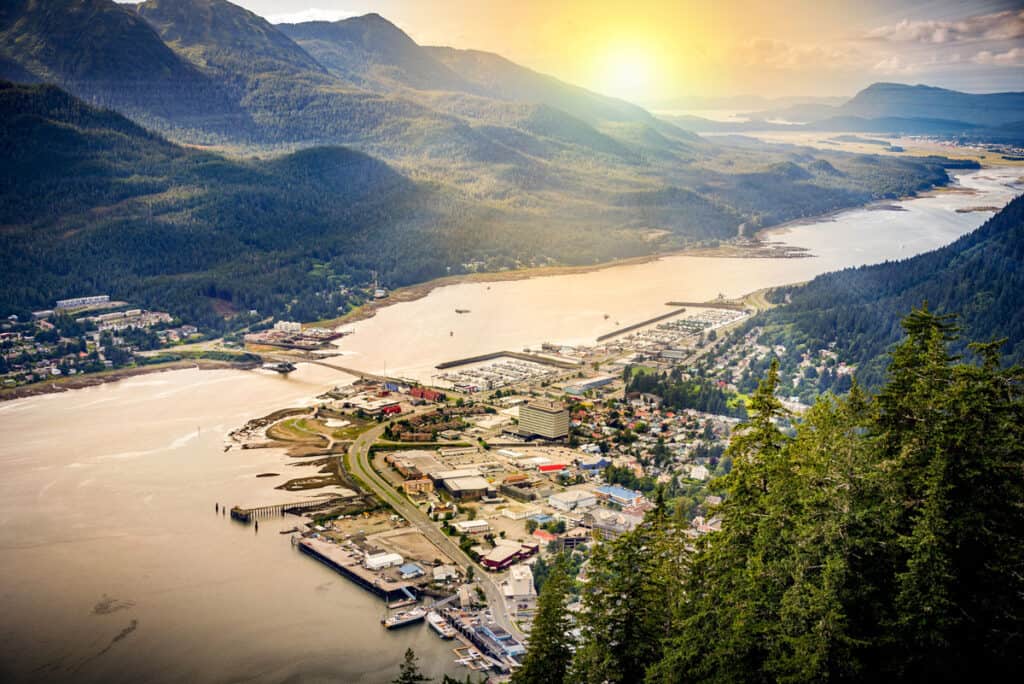
Juneau is Alaska’s capital and is found huddled between two mountain ranges.
©iStock.com/chaolik
Juneau is the state of Alaska’s capital and the third-largest city in terms of population. According to the 2020 United States Census data, Fairbanks, AK, has a population of 32,195. In terms of population density, the city is 12 per square mile.
This city is moderately diverse, with the race breakdown being:
- White 64.7%
- Black or African American 1.0%
- American Indian or Alaska Native 10.1%
- Asian 6.7%
- Native Hawaiian or Other Pacific Islander 1.3%
- Two or more Races 14.3%
- Hispanic or Latino 7.0%
- White alone, not Hispanic or Latino 62.5%
Juneau spreads further than most cities, as it spans 3,255 square miles. Due to this, the city’s population density tends to look small, as there is so much land. Juneau’s gross domestic product in 2021, it’s $2,228,455 thousand.
The major industries in Juneau include money management, producing timber, and studying mineral rights diversification. Significant employers include SEARHC, Goldbelt, and Alaska Travel Adventures, Inc. Recently, Juneau has had more affordable housing than other areas in Alaska.
Juneau’s climate is enjoyable, as it has a year-round ice-free harbor. In addition, the town has a subarctic-maritime environment. This means the winters are moist and long but have a milder summer. The Mendenhall Glacier is always recommended for any who visit, as it’s lined with ice caves you can hike through.
#4: Wasilla
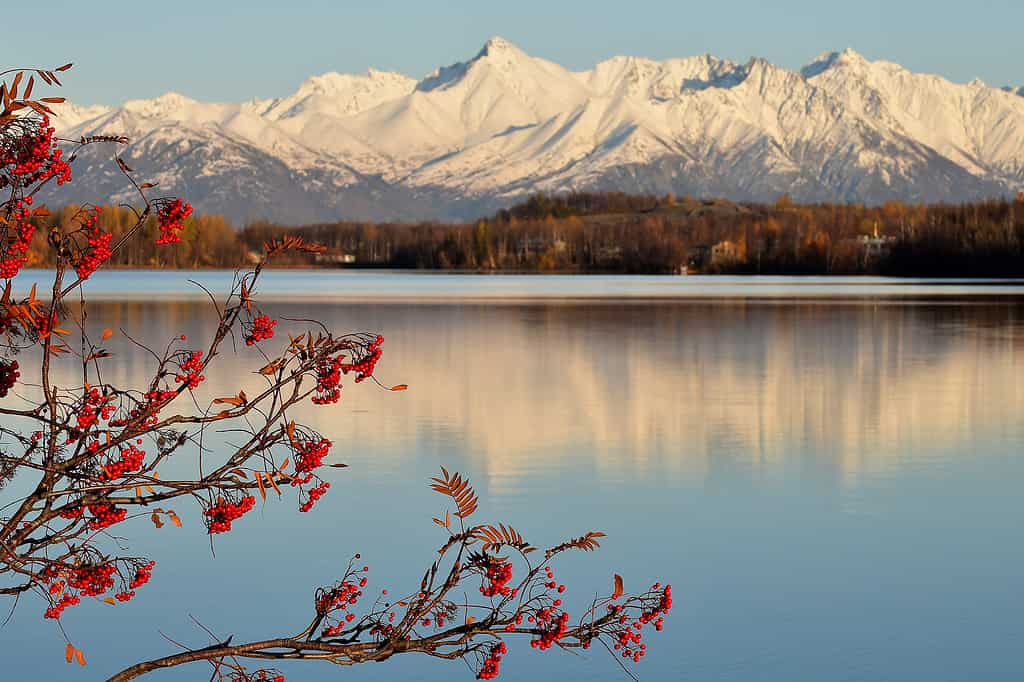
The Wasilla Lake is right next to the town and offers fantastic summer views.
©JT Fisherman/Shutterstock.com
Wasilla is a smaller town and one of Alaska’s largest places. While it isn’t a city, the town still has a decent-sized population. According to the United States Census 2020 data list, Wasilla has a population of 9,054 people. The population density is estimated to be around 821 people per square mile.
Wasilla is far less diverse than other areas in the state. Below are the estimates on race:
- White 79.4%
- Black or African American 0.9%
- American Indian or Alaska Native 7.0%
- Asian 3.7%
- Native Hawaiian or Other Pacific Islander 0.7%
- Two or more Races 7.0%
- Hispanic or Latino 5.8%
- White alone, not Hispanic or Latino 76.4%
Wasilla covers a total of 13.13 square miles and is one of the smaller places in the state. However, it’s mainly known for its small farming communities located around the area. The gross domestic product in 2021 is unavailable.
Wasilla’s primary industry includes steel fabrication, agriculture, manufacturing concrete products, wood, and distribution of building materials. Significant employers include Mat-Su Health Services, Inc, Mat-Su Services for Children and Adults, and the Drudge Report. Wasilla is one of the fastest-growing cities in Alaska.
The town is known for sitting at the base of Hatcher Pass, which leads to 3,886 feet elevation. The climate type for the area is subarctic, and visitors should check out Nacy Lakes.
#5: Sitka
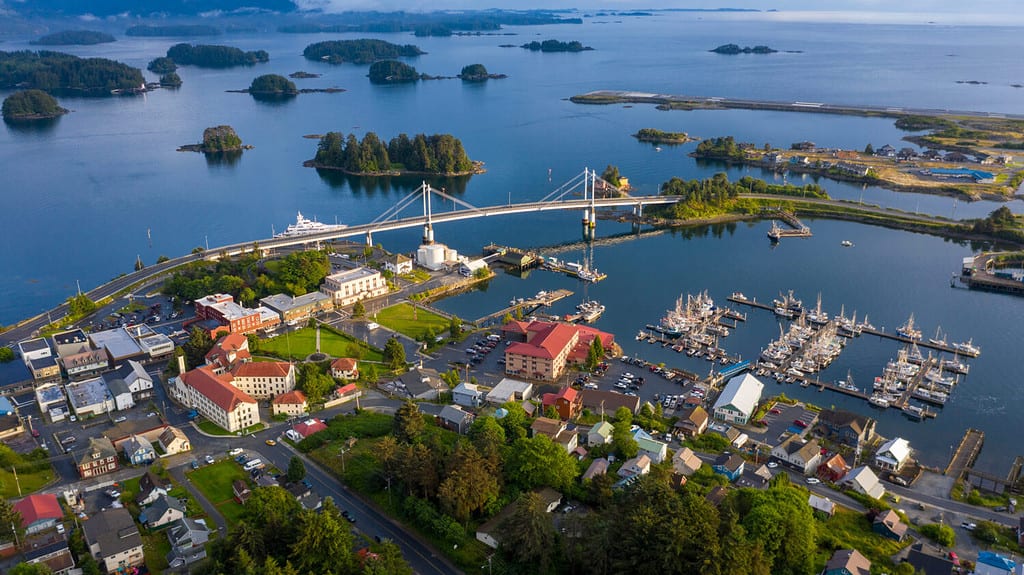
Sitka’s location makes it the perfect place for fishing, canning, and more.
©Roman Tigal/Shutterstock.com
Sitka, AK, is a unified city-borough on the west side of Baranof Island in the Alexander Archipelago. The United States Census data for 2020 states that Sitka has a small population of 8,458 people. Additionally, the population density is three people per square mile.
Here are the following breakdowns for race in the small town:
- White 63.5%
- Black or African American 0.6%
- American Indian or Alaska Native 10.3%
- Asian 7.3%
- Native Hawaiian or Other Pacific Islander 0%
- Two or more Races 17.4%
- Hispanic or Latino 7.1%
- White alone, not Hispanic or Latino 61.4%
The small town of Sitka spans an impressive 4,815 square miles, so the density is so low. Sitka also has a gross domestic product in 2021 of $513,094 thousand.
Sitka’s primary industries include healthcare, fishing, canning, lumbering, and tourism. Major employers include the Southeast Regional Healthcare Consortium (SEAHRC), Silver Bay Seafoods, and the Northern Southeast Regional Aquaculture Association. Sitka is seeing a job increase, with over 600 new openings.
The town sits on the outer coast of Inside Passage, which is directly next to the Pacific Ocean. It also borders Tongass National Forest, the largest Temperate Rain Forest in the world. For climate, the area is an oceanic type with moderate temperatures and is generally cool with high precipitation.
#6: Ketchikan

Ketchikan is one of the smallest in terms of landmass but has a big population.
©Anthony Ricci/Shutterstock.com
Ketchikan is a miniature village located in the state’s southeastern part and is Alaska’s First City. According to the United States Census data for 2020 lists, Ketchikan has a population of 8,192. The population density is 2,063 people per square mile.
The small town of Ketchikan is less diverse but still has a small variety of races:
- White 55.2%
- Black or African American 1.1%
- American Indian or Alaska Native 18%
- Asian 13.3%
- Native Hawaiian or Other Pacific Islander 0.3%
- Two or more Races 10.6%
- Hispanic or Latino 6.1%
- White alone, not Hispanic or Latino 52.9%
Ketchikan is very small and only spans 4.9 square miles. The small square mileage and high population make this town very compact. This is because most residents live inside buildings lined alongside the southeastern coast. Its GDP is estimated to be at $957,850 thousand for the borough.
Ketchikan’s major industries include fishing, canneries, tourism, and forestry. Major employers are the Ketchikan General Hospital, Alaska Forest Association, and the Ketchikan Indian Community.
Ketchikan is named after Ketchikan Creek, which runs through the town into the Tongass Narrows. If visiting, the Alaska Rainforest Sanctuary has plenty of outdoor nature and wildlife. The climate tends to be mild maritime and oceanic, known as the Rain Capital of Alaska.
#7: Kenai

The Kenai River is a popular kayaking area and is often a tourist location during the summer and spring.
©Keri Ann Riley/Shutterstock.com
Kenai is a small area with a low population but is often a popular destination for fishing. The United States Census has reported a population of 7,424 as of 2020. Its population density is approximately 269 per square mile.
Kenai’s breakdown of race is the following:
- White 71.8%
- Black or African American 1.4%
- American Indian or Alaska Native 11.7%
- Asian 3.8%
- Native Hawaiian or Other Pacific Islander 0.4%
- Two or more Races 7.6%
- Hispanic or Latino 7.2%
- White alone, not Hispanic or Latino 70%
The town only spans 35.97 square miles, which is relatively small. Up to 5.6 square miles of the area is water as the town is a coastal. As for the gross domestic income, Kenai, AK, is $3,070,355 thousand for 2021.
Kenai’s primary industry includes oil, natural gas, commercial fishing, and tourism. Significant employers include Access Alaska, Sockeye’s Restaurant at Kenai Landing, and Arctic Pipe Inspection. Over the past two decades, Kenai has seen massive growth in healthcare services, oil and gas employment.
Kenai has many geographical wonders, but most notably, the town is on the Kenai River. Seeing the Kenai Fjords National Park is highly recommended if you’re visiting the area. The climate in the area is a moderate dry-summer subarctic with cool summers and long snowy winters.
#8: Palmer
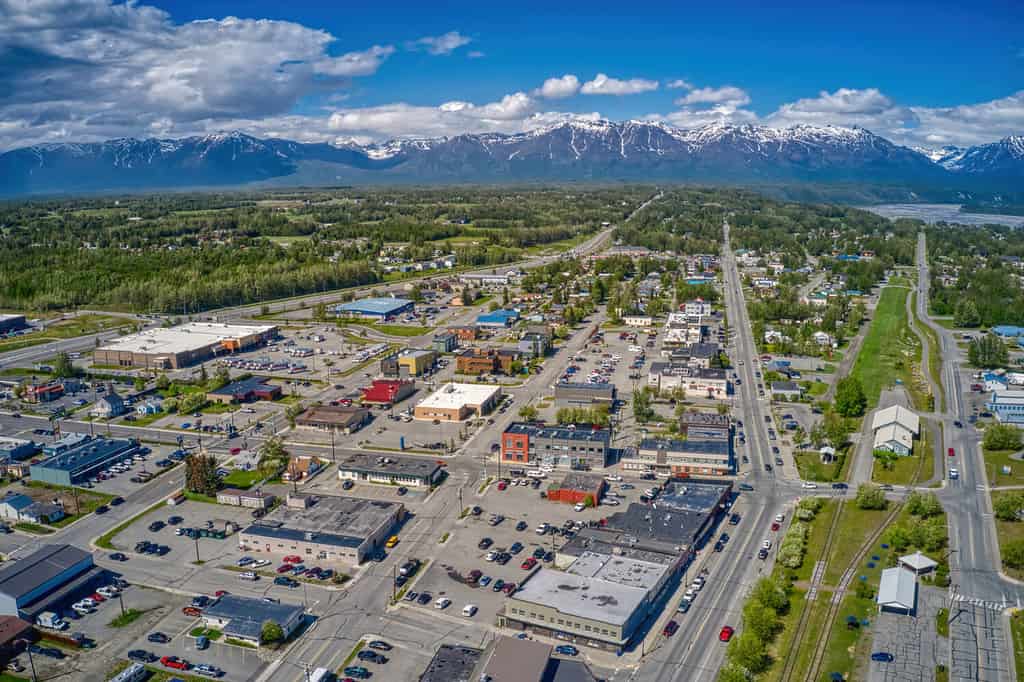
Palmer is more modernized and has good healthcare and retail industries despite its small size.
©Jacob Boomsma/Shutterstock.com
Palmer is a small farming community in the Matanuska-Susitna Valley in the Southcentral region. In 2020, the United States took population data, which resulted in a total of 5,888 people. For density, Palmer, AK, has 1,286 people per square mile. The race breakdown is moderate and similar to other areas in Alaska.
Here are the percentages:
- White 72.4%
- Black or African American 3.5%
- American Indian or Alaska Native 8.7%
- Asian 1.3%
- Native Hawaiian or Other Pacific Islander 2.1%
- Two or more Races 10.3%
- Hispanic or Latino 7%
- White alone, not Hispanic or Latino 68.9%
The small town of Palmer, AK, spans 5.07 square miles, which isn’t that big. In fact, it’s similar to the size of Ketchikan but doesn’t have as big of a population per square mile. The GDP was not available for this area.
Palmer has major industries in healthcare, retail trade, and public administration. Significant employers include MSBSD, Matanuska Telephone Association, and New Horizons Telecom, Inc. One trend is that future job growth will rise by 19.5% in Palmer, AK.
The small town of Palmer is flanked between the Matanuska Glacier and the Knik Glacier. Both of these are located in the Matanuska and Knik Valleys. The climate type is a subarctic climate with more precipitation than the rest of the state.
#9: Bethel
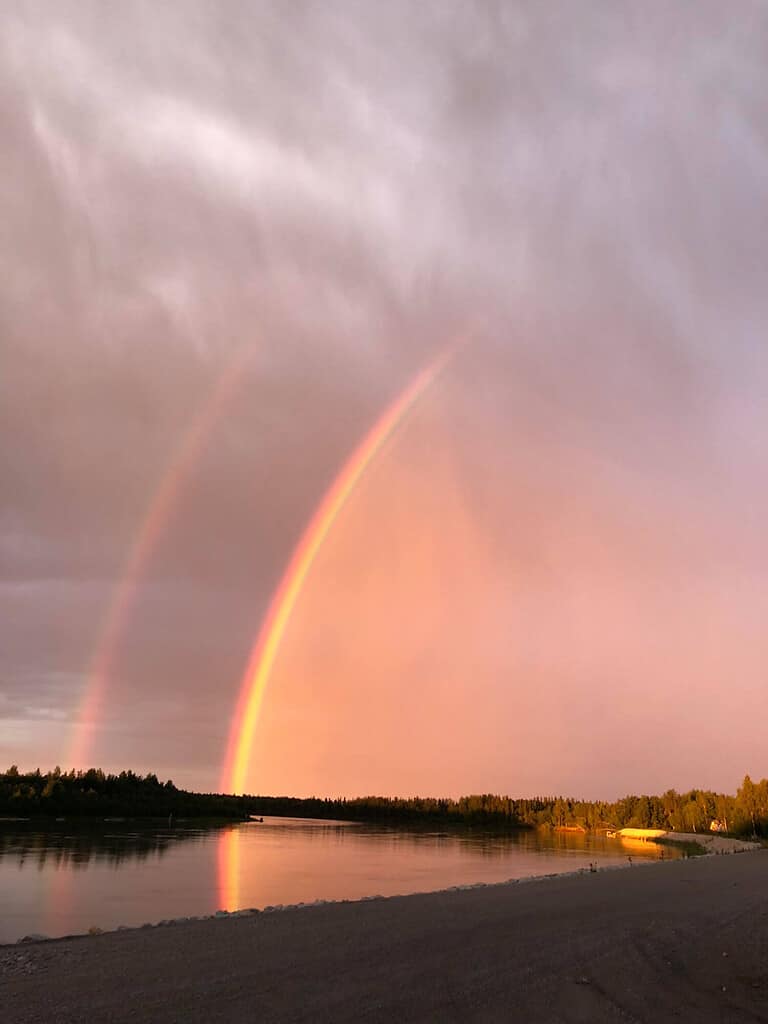
The Kuskokwim River is one of the longest rivers in Alaska.
©JenniLovesTheVillage/Shutterstock.com
Bethel is one of the smaller cities in the state, but it still ranks as one of the largest cities in Alaska. According to the United States Census data in 2020, Bethel, AK, the population is 6,325, with 141 people per square mile.
It’s as follows:
- White 23%
- Black or African American 2.4%
- American Indian or Alaska Native 65.2%
- Asian 3.9%
- Native Hawaiian or Other Pacific Islander 0.6%
- Two or more Races 4.3%
- Hispanic or Latino 5.3%
- White alone, not Hispanic or Latino 22%
The Bethel area is a bit bigger than other small towns in Alaska and spans 50.11 square miles. Then, the gross domestic product in 2021, which is the latest, is $723,486 thousand.
Bethel’s major industries include services and government. Significant employers include Aflac, Alaska Airlines, and Yukon-Kuskokwim Health Corp. There is a high incidence of unemployment, which makes Bethel’s census area’s per capita income lower than the state’s average.
The town of Bethel is the main port of the Kuskokwim River. Visitors should see the Yukon Delta National Wildlife Refuge, which holds plenty of Alaskan wildlife. The climate type is subarctic and has long and snowy winters but mild summers.
#10: Homer
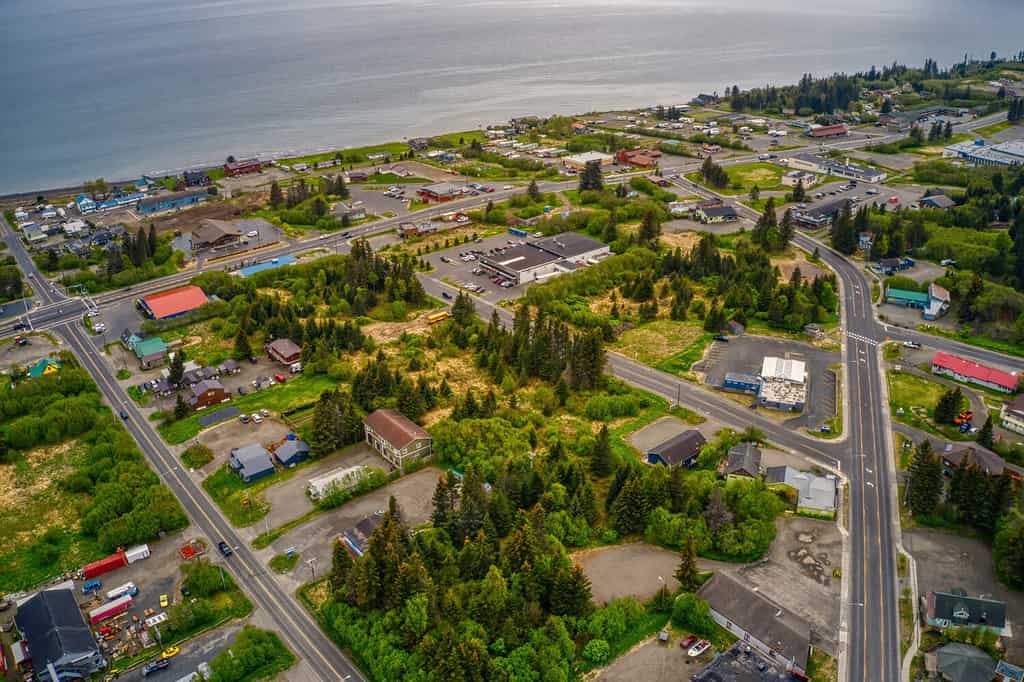
Homer is seeing higher real estate prices than ever before.
©Jacob Boomsma/Shutterstock.com
Homer, AK, is the last on our list and is the smallest “largest” city. The 2020 United States Census data list that Homer has a total population of 5,522 with a density of 441 people per square mile.
The diversity in the area is the least varied:
- White 82.6%
- Black or African American 0.3%
- American Indian or Alaska Native 7.3%
- Asian 1.7%
- Native Hawaiian or Other Pacific Islander 0.1%
- Two or more Races 7.4%
- Hispanic or Latino 5.2%
- White alone, not Hispanic or Latino 80.3%
Homer only spans only 25.25 square miles along Kachemak Bay. It’s a small fishing town, with its main export being fish. Homer’s gross domestic product was not available.
Major industry sectors in Homer, AK, include commercial fishing, tourism, and government. The South Peninsula Hospital, Kenai Peninsula Housing Initiatives, and South Peninsula Haven House are major employers. Residential and commercial real estate markets are gaining value.
Homer is right along the northern shore of Kachemak Bay. Many people come to see the Homer Spit, as it’s one of the only friendly beaches in Alaska. The climate tends to be a moderate subarctic Mediterranean, unique to Alaska.
The photo featured at the top of this post is © Naruedom Yaempongsa/Shutterstock.com
Thank you for reading! Have some feedback for us? Contact the AZ Animals editorial team.







